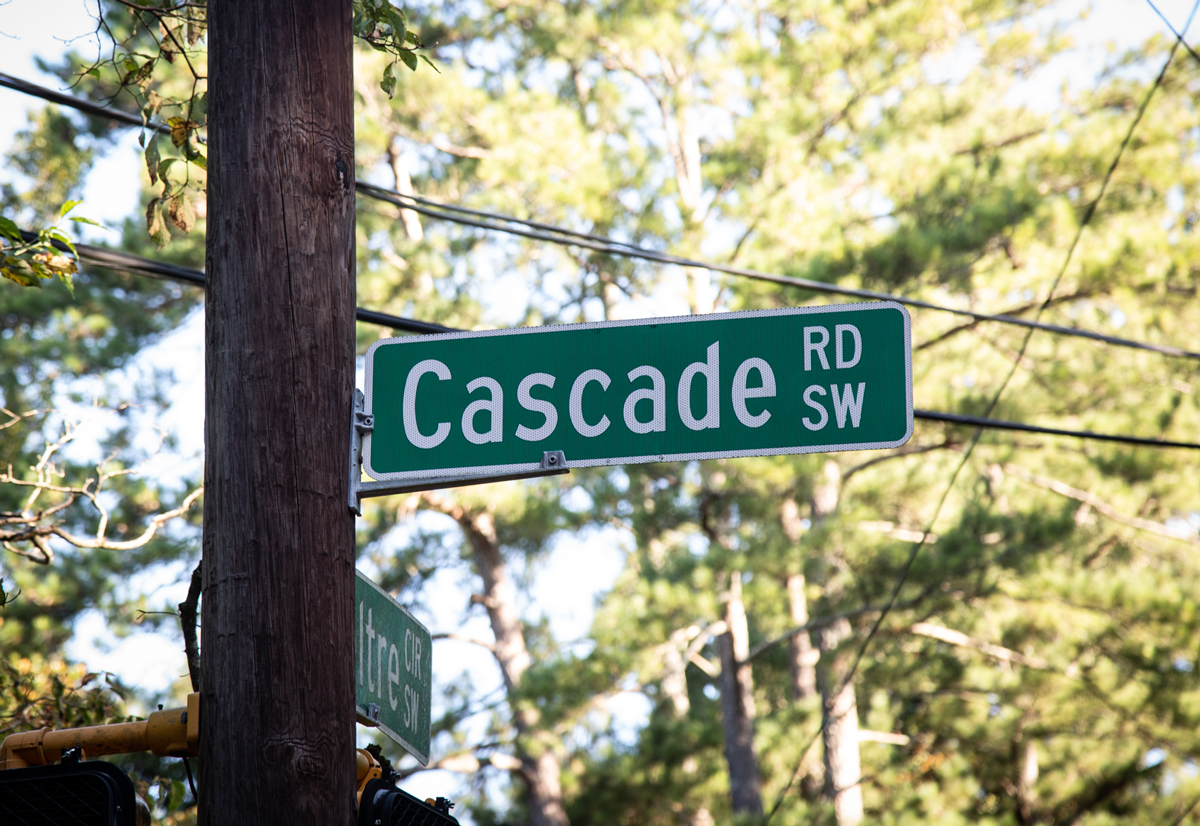
Photograph by Martha Williams
This story is part of Atlanta magazine’s Streets Issue—a block-by-block exploration of our city and the stories it tells. Find the entire package here.
Late last year, the discount grocer Aldi began seeking rezoning approval to open a new store in the Cascade Heights neighborhood. Located just off I-285, the store would be built across Cascade Road from a busy plaza that’s currently home to Kroger, Bank of America, and other retailers; a Publix and a Walmart Supercenter are a stone’s throw away. Aldi declined to comment on the progress of store plans but, if completed, it would be the fourth option within less than a mile for local residents to obtain fresh produce.
I spent much of my childhood living on Cascade Road and shopping at that Publix, and people much more famous than me have called Cascade home: Atlanta’s last three mayors live in the area. So did Hank Aaron. I became friends with the novelist Tayari Jones when we bonded over our shared love for Cascade Road, which she’s written about movingly in her fiction. In 1962, the City of Atlanta built a literal wall to try to keep Black residents out of what was then an all-white neighborhood, but, in recent decades, Cascade Heights—with its affluent gated communities, signature tree canopy, and casual celebrity sightings—has become emblematic of Atlanta’s status as a “Black Mecca.”
At the same time, it’s served as a reminder that even the most affluent Black neighborhoods often lack the amenities of similar white neighborhoods. Mayor Bottoms, for instance, earlier this year tweeted a photo of bare shelves at the Cascade Publix, noting that outlets in other areas, like Vinings and Buckhead, didn’t seem to be experiencing similar problems. (Publix, in response, blamed the disparity on supply-chain issues.)
But Cascade is also distinct from nearby locales in that its residents don’t lack fresh food from traditional retailers. I was fascinated to learn that yet another was moving in—even more so when I came across a city-created map of fresh-food options, where that cluster of stores stands in contrast to the rest of Southwest Atlanta, and the other predominantly Black neighborhoods where grocers are few and far between. Why the abundance in Cascade Heights? And how does a Black neighborhood that needs a grocer get one?
Atlanta has long struggled with food deserts: large areas where residents, often low-income, don’t have easy access to fresh groceries. Before Bottoms left office, her administration set a goal of having at least 85 percent of Atlanta residents located within half a mile of “fresh affordable food” by 2022. The initiative has shown results: As of 2020, 75 percent of residents fit the description—an increase from 52 percent in 2015. (Asked whether Bottoms’s 2022 goal had been reached, a spokesperson said the City is still collecting data.) Still, a USDA agricultural economist told the nonprofit news outlet Capitol Beat last year that, statewide, Georgia has the “sixth highest share of low-income areas whose residents also lack adequate access to supermarkets.”
NPU-I, the majority-Black neighborhood planning unit that encompasses Cascade Road, mostly supported the Aldi rezoning proposal, said chairwoman Eunice Glover. Michael DiYorio, who attends NPU-I meetings, told me he voted no only because he hoped a grocery would instead be placed along Martin Luther King Jr. Drive, a relatively less affluent thoroughfare north of Cascade. Diyorio, who lives just off MLK in Florida Heights, mostly shops at small, independent Westview Corner Grocery or drives to the Publix on Marietta Boulevard. “Timewise, it usually takes me about 20 minutes,” he says—though that beats the parking lot traffic at the West End Kroger.
I called Creighton Fearrington, an NPU-I committee chair who focuses on zoning and land use, to better understand how Aldi might have picked Cascade as the street for a future location. “Their business model is a little different than a Publix, Kroger, Walmart, or Target,” Fearrington said. “Those are what you call an anchor grocery or retail store. They build and everyone else kind of fills in—your Pizza Hut, Subway, nail shops.” The Aldi model relies on proximity to stores that are already established: “They try to locate themselves within a certain distance of those anchor-type [stores] and offer a value proposition to potential customers,” Fearrington said.
Grocery retailers usually look at a number of things, including traffic counts, when deciding if they should open in a certain location. That’s likely another reason why the stretch of Cascade Road near 285 has so many. By contrast, Wayfield Foods looked into opening a store on Pryor Road in 2013 but ultimately declined—citing the low traffic count among other reasons, says Jeff Delp, the director of economic development for the nonprofit Focused Community Strategies. A few years later in South Atlanta, FCS opened the independent grocery Carver Market, the kind of small neighborhood store that could help fill the food-access gap in places where major retailers won’t. They already have: Atlanta’s 2020 Fresh Food Access Report, tracking the progress of Bottoms’s goal, noted that neighborhood markets have played a “key role” in expanding food access, including in low-income, formerly low-access areas.
Still, Delp says, grocers such as Carver Market are only viable if they’re located near activity centers (in Carver’s case, a high school) that will bring repeat customers who won’t just drive to bigger grocery retailers. Even with the increased importance of independent markets, Delp notes, food access is an issue that will need to be addressed with long-term planning—big, citywide questions about issues such as transportation and zoning that extend far beyond the scope of any one store, street, or neighborhood. How can a city whose population is heavily reliant on cars best address food access, especially if retailers are likely to gather near the interstate along popular streets? People like DiYorio are inconvenienced when there aren’t many fresh food options nearby—but, ultimately, he’s able to easily leave his neighborhood. What happens to people who can’t?
From “Caramel,” a short story by Tayari Jones
“The Right Reverend Dr. Lerome ‘Romie’ Johnson lives two turns off Cascade Road, and so do I. The difference is that I live in the West End where the primary business establishments are strip clubs, churches, and beauty supply shops. The only modern convenience is the chrome-and-glass Krispy Kreme said to be owned by Hank Aaron. The reverend, on the other hand, lives ten miles west down this same road, but down there subdivisions sit back from the street, protected by wrought-iron gates, softened with twists and curlicues. This is something that never ceases to amaze me about Atlanta: whatever you can think of, there is a black person doing it—probably up and down Cascade Road. Crackheads, CEOs, and everything in between.”
From Atlanta Noir, edited by Tayari Jones. Reprinted with permission from Akashic Books. ©2017 Tayari Jones.
This article appears in our August 2022 issue.













